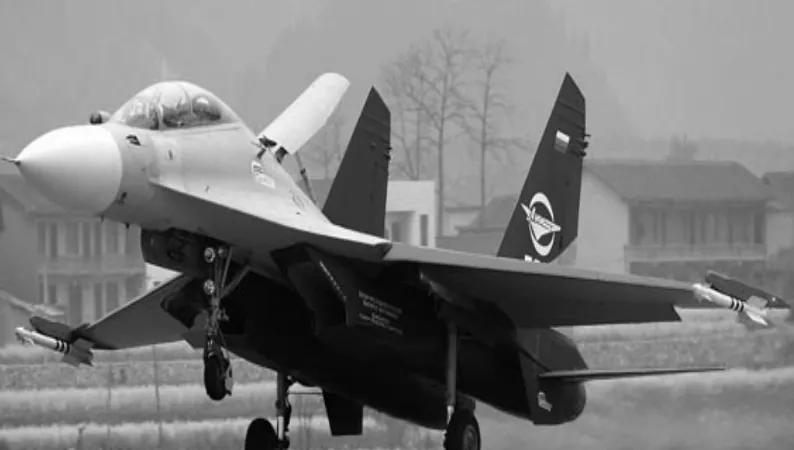With only 5 months left before the J-11B test flight, the military workers were trapped by a piece of glass! The third-generation machine composite materials have been successfully developed, is it necessary to introduce foreign products because of a piece of glass?
The J-11B is a domestically produced model based on the introduction of the Su-27SK fighter.
In 1996, after four years of trials, China signed a contract with Russia to introduce and produce 200 of Russia's most advanced SU-27SK fighter jets.
And in Shenyang Aircraft Industry Company set up an independent new advanced plant, the use of Western and domestic most advanced production equipment imitation of the aircraft, in 1999, the first batch of localization of 70% of the fighter factory, renamed J-11, later called J-11A.
However, with the rapid development of aviation technology in the late 1990s, the Su-27 and J-11A have quickly lagged behind, especially their avionics equipment is outdated and unreliable.
To this end, in 2000, the J-11B multi-purpose heavy fighter built entirely using domestic advanced aviation technology was secretly launched, in addition to maintaining an aerodynamic shape, its modification to the Su-27SK is tantamount to redevelopment, known as project 11.
The development of the J-11B fighter adopts a large number of resin composite materials, and the airborne equipment includes environmental control systems, fly-by-wire flight control systems, fire control systems, etc. are all the most advanced equipment developed by themselves at that time.
In this process of localization, the military workers have paid great hardships. Because localization means producing aircraft parts with its own materials. However, at that time, the continental aviation materials were still at the level of the second-generation aircraft.
There is a saying in the aviation industry called "a generation of materials, a generation of aircraft". This means that aircraft and aviation materials are interdependent, mutually reinforcing, and closely related.
In order to achieve the requirements of high performance, lightweight, high reliability, long life and low cost of more advanced generation aircraft, the research and development of new generation materials is an important technical guarantee.
Among the hundreds of materials used in the J-11B, including fuselage skin, frame, all the way to the airborne equipment and engine, metallic, non-metallic, is a huge family. Among them, the material of the engine is undoubtedly very important.
Wu Xueren, then chief engineer of the Beijing Aeronautical Materials Research Institute, recalled that when communicating abroad, the foreign side came up with a PPT, saying that in the 21st century, the contribution rate of materials to high-performance engines reached 78%.
Other fuselage and wing materials (wing-body fusions) that need to withstand abnormal overloads require light and strong, corrosion resistance, long life, and damage resistance.
As a result, titanium alloys and composite materials began to be used in a large number of new generation aircraft. Among them, composite materials as a man-made non-metallic material lighter than metal materials, at that time the industrial sector of the mainland was not yet able to manufacture composite materials suitable for third-generation machines.
It can be said that if the material problem is not solved, the third-generation machine cannot be created.
Composite materials are woven and combined from materials with different properties, and the advantages of different materials are combined to make artificial materials that meet the needs of a new generation of fighters.
In order to solve the material problem, led by the Beijing Institute of Aeronautical Materials, led by more than 100 units across the country to tackle key problems, after nearly 10 years of efforts, finally basically solved the problem of localization of materials.
However, just five months before the scheduled test flight, the front windshield of the J-11B fighter, which was not the focus of the attack, was difficult for the military workers.
The front windshield of the second-generation aircraft is flat, while the third-generation aircraft is a curved windshield, and the problem of optical distortion must be overcome, otherwise the pilot's forward field of view will be deformed, which will seriously affect the pilot's driving and combat.
The unit originally responsible for the development of the windshield was not successful due to distortion problems.
With only five months left before the first flight, the time is too tight, is it necessary to introduce foreign products because of a front windshield?
The researchers felt unacceptable. To this end, the Institute of Aeronautical Materials was ordered to take over this problem, and after urgent consultation with Shenyang Institute, came up with a plan for bubble-shaped transparent parts to overcome the problem of optical distortion.
This is a highly technical work, including thermoforming, coating, assembly linking and testing, etc., and is a multidisciplinary integrated project.
In the research stage, the transparent parts research team wanted to buy a key equipment, which cost 2.3 million yuan, exceeding the budget. More than 2,000 employees of the Institute of Aeronautical Materials willingly contributed their annual bonus of 8,000 yuan to support the transparent parts research group to purchase equipment to overcome this problem.
At the last moment, the Institute of Aeronautical Materials finally overcame the problem of transparent parts. The domestically produced J-11B made its maiden flight on time.
It can be said that the successful development of the J-11B domestically produced aircraft is inseparable from the major breakthroughs made by the military workers at that time in the development and application of a series of new aviation materials. The development methods, application scenarios and capability systems of new materials established by this are playing an increasingly important role in the development process of new fighters.
